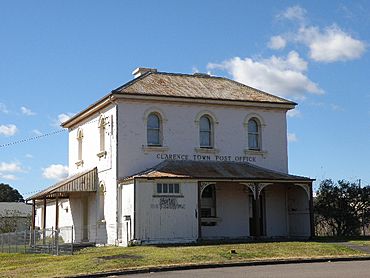Clarence Town, New South Wales facts for kids
Quick facts for kids Clarence TownNew South Wales |
|||||||||||||||
|---|---|---|---|---|---|---|---|---|---|---|---|---|---|---|---|

Clarence Town Post office
|
|||||||||||||||
| Population |
|
||||||||||||||
| Postcode(s) | 2321 | ||||||||||||||
| Elevation | 13 m (43 ft) | ||||||||||||||
| Time zone | AEST (UTC+10) | ||||||||||||||
| • Summer (DST) | AEDT (UTC+11) | ||||||||||||||
| Location |
|
||||||||||||||
| LGA(s) | Dungog Shire | ||||||||||||||
| Region | Hunter | ||||||||||||||
| County | Durham | ||||||||||||||
| Parish | Uffington | ||||||||||||||
| State electorate(s) | Upper Hunter | ||||||||||||||
| Federal Division(s) | Lyne | ||||||||||||||
|
|||||||||||||||
Clarence Town is a small town and a wider rural area in the Hunter Region of New South Wales, Australia. It is part of the Dungog Shire, which is a local government area. The town is about 193 kilometres (120 miles) north of Sydney. It is also 54 kilometres (34 miles) north-north-west of Newcastle.
The Williams River flows right through the area. The main part of Clarence Town sits just west of this river. It is about 32 kilometres (20 miles) upstream from where the Williams River joins the Hunter River.
Contents
A Glimpse into Clarence Town's Past
The land where Clarence Town now stands was first home to the Wanaruah Aboriginal people. They called this area Erringhi.
Early European Exploration and Settlement
The first Europeans to visit this area were William Paterson and Francis Barrallier in 1801. They were exploring the Hunter River. Around the same time, convicts were sent here to cut timber. By 1826, more cedar cutters had moved in, and a small village began to form.
How Clarence Town Got Its Name
Clarence Town is famous for a special event in 1831. A paddle steamer called the William IV was built and launched here. At that time, the town was still known as Erringhi. In 1832, the town was renamed after the Duke of Clarence. He became King William IV in 1830.
In 1886, people described the land near the river as very rich and good for farming. This was because of floods over many years. Farmers grew crops like wheat, maize, barley, oats, and potatoes. They also grew tobacco, grapes, and oranges. Back then, about 370 people lived in the town.
Today, you can still see The Erringhi Hotel on the main street. It was built in 1913.
Important Historic Places
Clarence Town has some buildings and places that are important to its history. These are called heritage-listed sites.
- 49 Grey Street: This is the Clarence Town Courthouse.
- 567 Main Road: This is the Clarence Town Bridge over Williams River.
Who Lives in Clarence Town?
In 2006, about 2,100 people lived in the wider Clarence Town area. The town itself, which is the biggest part, had a population of 794 people.
What's in Clarence Town Today?
Clarence Town has many things for its residents and visitors.
- A post office (built around 1880)
- A Medical Centre and a Pharmacy
- A supermarket (IGA)
- A primary school
- Several churches
- A school of arts hall, where many local events are held
- A soccer club (home of the Clarencetown Cobras)
- A field for football and cricket
- A fire station and a police station
- A butcher shop, a club, a pub, a hardware store, and a restaurant
- A vet clinic
- A caravan park by the river
- A swimming pool (home of the Clarencetown Comets swimming team)
You can also find nice picnic spots and old buildings to explore.
Good Samaritan Donkey Sanctuary
Just outside of town, there is a special place called the Good Samaritan Donkey Sanctuary. This sanctuary takes care of donkeys that have been mistreated. Visitors are welcome, but you usually need to make an appointment. Sometimes, they have special open days where everyone can visit.
Major Flooding Event
In June 2007, very serious floodwaters hit the Hunter Valley region. This caused a lot of damage in Clarence Town. Sadly, some people did not survive when a bridge leading into Clarence Town from Seaham, New South Wales was affected by the flood.


